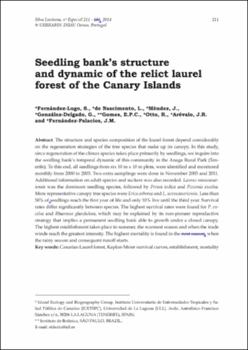Seedling bank’s structure and dynamic of the relict laurel forest of the Canary Islands
Date
2014Abstract
The structure and species composition of the laurel forest depend considerably
on the regeneration strategies of the tree species that make up its canopy. In this study,
since regeneration of the climax species takes place primarily by seedlings, we inquire into
the seedling bank’s temporal dynamic of this community in the Anaga Rural Park (Tenerife).
To this end, all seedlings from six 10 m x 10 m plots, were identified and monitored
monthly from 2000 to 2003. Two extra samplings were done in November 2005 and 2011.
Additional information on adult species and suckers was also recorded. Laurus novocanariensis
was the dominant seedling species, followed by Persea indica and Picconia excelsa.
More representative canopy tree species were Erica arborea and L. novocanariensis. Less than
50% of seedlings reach the first year of life and only 10% live until the third year. Survival
rates differ significantly between species. The highest survival rates were found for P. excelsa
and Rhamnus glandulosa, which may be explained by its non-pioneer reproductive
strategy that implies a permanent seedling bank able to growth under a closed canopy.
The highest establishment takes place in summer, the warmest season and when the trade
winds reach the greatest intensity. The highest mortality is found in the next season, when
the rainy season and consequent runoff starts.






